Health
Digital Solutions Revolutionize Elder Care and Public Health Amid Aging Challenges

CANBERRA, Australia — As economies grapple with the increasing challenge of aging populations, traditional healthcare systems often struggle with insufficient infrastructure and trained personnel. A recent publication highlights how digital technologies like robotics and telemedicine can enhance elder care and promote inclusive development.
This week, the AEHRC held its 21st Annual Research Colloquium, featuring over 300 participants who explored the latest trends in digital health. The event focused on how emerging technologies can address pressing health issues, including pathogen detection and eldercare solutions.
Aminath Shausan, a member of the AEHRC research team, presented findings on mapping antimicrobial-resistant infections in remote regions of Australia. Her work emphasizes the need for innovative approaches in healthcare to protect communities from both individual and societal health threats.
Laurence Wilson’s team is leveraging artificial intelligence (AI) to understand vaccine efficacy in combatting COVID-19 and flu, investigating immune responses to enhance vaccination strategies. “By targeting specific pathways in pathogens, we can develop more effective vaccines,” Wilson said during the colloquium.
One significant showcase featured Jatinder Sidhu’s work on detecting viral pathogens in wastewater, offering a means to identify and track emerging viruses before they spread. This approach allows for a proactive public health response, crucial in today’s rapidly changing health landscape.
AI technology also plays a role in diagnostics, with Pierrick Bourgeat demonstrating advancements in analyzing positron emission tomography (PET) images for Alzheimer’s disease diagnosis. Early detection is essential for treatment, making this research a vital component of elder care.
Maria Antico introduced an innovative wearable ultrasound device designed for remote use, developed in collaboration with the Queensland University of Technology. This device is based on AI, which simplifies image interpretation, allowing users without specialized training to utilize ultrasound technology effectively.
The colloquium also addressed data interoperability challenges within the aged care sector. Liesel Higgins presented a report identifying these gaps and proposing measures to enhance data sharing and integration. “Good healthcare relies on effective data collection and sharing,” Higgins noted.
John Grimes showcased his team’s integration of cardiovascular risk assessment software in GP systems, streamlining preventative care for one of Australia’s leading health concerns.
Highlighting the importance of tailored solutions, researchers from AEHRC’s Indigenous Health Team partnered with the University of Western Australia to develop Kara-Care, a digital health tool aimed at supporting Aboriginal health services in the Pilbara region. “This tool can significantly improve health data accessibility for clinicians on the ground,” said a team member.
As digital health technologies advance, AEHRC scientists are focused on ensuring these innovations translate effectively into real-world applications. Yan Chia and Jason Dowling emphasized the necessity of robust testing and certification for medical software to guarantee quality and readiness for market deployment.
The future of digital health promises to enhance not only elder care but also the overall public health landscape in Australia. As researchers continue to innovate, the integration of these technologies offers hope for healthier and more inclusive communities.












